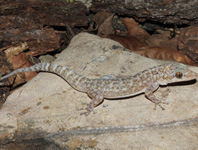Abstract
This paper describes a new genus of Nesticidae based on morphology of the genital characters and supported by molecular data. The new genus, Domitius n. gen., includes a group of seven cave-dweller species spread along western European peninsulas (Iberian and Italian). Molecular phylogenetic analysis shows that these species constitute an independent and highly supported evolutionary lineage being the sister group to Kryptonesticus Pavlek & Ribera, 2017, Nesticus Thorell, 1869 and Carpathonesticus Lehtinen & Saaristo, 1980 genera. As a result, seven new combinations are here proposed: Domitius baeticus (López-Pancorbo & Ribera, 2011) n. comb., Domitius murgis (Ribera & De Mas, 2003) n. comb., Domitius lusitanicus (Fage, 1931) n. comb., Domitius luquei (Ribera & Guerao, 1995) n. comb., Domitius sbordonii (Brignoli, 1979) n. comb., Domitius menozzii (Caporiacco, 1934) n. comb., Domitius speluncarum (Pavesi, 1873) n. comb.
References
Bidegaray-Batista, L. & Arnedo, M.A. (2011) Gone with the plate: the opening of the Western Mediterranean basin drove the diversification of ground-dweller spiders. BMC Evolutionary Biology, 11, 317.
https://doi.org/10.1186/1471-2148-11-317Bidegaray-Batista, L., Ferrández, M.A. & Arnedo, M.A. (2014) Winter is coming: Miocene and Quaternary climatic shifts shaped the diversification of Western-Mediterranean Harpactocrates (Araneae, Dysderidae) spiders. Cladistics, 30, 428–446.
https://doi.org/10.1111/cla.12054Bird, P. (2003) An updated digital model of plate boundaries. Geochemistry, Geophysics, Geosystems, 4 (3), 1–52.
https://doi.org/10.1029/2001GC000252Brignoli, P.M. (1971) Note sui ragni cavernicoli italiani. Fragmenta Entomologica, 7, 121–229.
Deeleman-Reinhold, C.L. (1974) The cave spider fauna of Montenegro (Araneae). Glasnik Republickog Zavoda za Zastitu Prirode i Prirodnjackog Muzeja Titogradu, 6, 9–33.
Deltshev, C., Ćurčić, B., Wang, C.X., Yao, Z.Y., Antic, D., Ćurčić, S. & Rada, T. (2014) New data on the spiders (Araneae) in the caves of Balkan peninsula. Archives of Biological Science Belgrade, 66 (2), 465–471.
https://doi.org/10.2298/ABS1402465DDresco, E. (1966) Étude de quelques espèces d’araignées du genre Nesticus (Fam. Nesticidae). Annales de Spéléologie, 21, 795–813.
Drummond, A., Ashton, B., Cheung, M., Heled, J., Kearse, M., Moir, R., Stones-Havas, S., Thierer, T. & Wilson, A. (2009) Geneious. Version 4.6.5. Auckland, New zealand. Available from: http://www.geneious.com/ (accessed 20 March 2018)
Katoh, K. & Toh, H. (2008) Improved accuracy of multiple ncRNA alignment by incorporating structural information into a MAFFT-based framework. BMC bioinformatics, 9, 212.
https://doi.org/10.1186/1471-2105-9-212Kumar, S., Stecher, G. & Tamura K. (2016) MEGA7: Molecular Evolutionary Genetics Analysis version 7.0 for bigger datasets. Molecular Biology and Evolution, 33 (7), 1870–1874.
https://doi.org/10.1093/molbev/msw054
Lanfear, R., Calcott, B., HoS, Y.W. & Guindon, S. (2012) PartitionFinder: Combined selection of partitioning schemes and substitution models for phylogenetic analyses. Molecular Biology and Evolution, 29, 1695–1701.
https://doi.org/10.1093/molbev/mss020
López-Pancorbo, A. & Ribera, C. (2011) Nesticus baeticus sp. n., a new troglobitic spider species from south-west Europe (Araneae, Nesticidae). ZooKeys, 89, 1–13.
https://doi.org/10.3897/zookeys.89.921Lopez-Pancorbo, A., Kunt, K.B., Blagoev, G., Deltshev, C. & Ribera, C. (2013) Nesticus dimensis new species, a new troglobitic spider from Turkey (Araneae, Nesticidae), with comments on its phylogenetic relationships. Zootaxa, 3721 (2), 183–192. https://doi.org/10.11646/zootaxa.3721.2.5
Marusik, Y.M. & Guseinov, E.F. (2003) Spiders (Arachnida: Aranei) of Azerbaijan. 1. New family and genus records. Arthropoda Selecta, 12 (1), 29–46.
Pavlek, M. & Ribera, C. (2017) Kryptonesticus deelemanae gen et sp nov (Araneae, Nesticidae), with notes on the Mediterranean cave species. European Journal of Taxonomy, 262, 1–27.
https://doi.org/10.5852/ejt.2017.262Pfliegler, W.P. (2014) Records of some rare and interesting spider (Araneae) species from anthropogenic habitats in Debrecen, Hungary. Acta Naturalia Pannonica, 7, 143–156.
Ribera, C., De Mas, E. & Barranco, P. (2003) Araneidos cavernícolas de la provincia de Almería (I) y descripción de cuatro especies nuevas. Revista Ibérica de Aracnología, 7, 3–17.
Ribera, C., Elverici, M., Kunt, K.B. & Özkütük, R.S. (2014) Typhlonesticus gocmeni sp. n., a new cave-dwelling blind spider species from the Aegean region of Turkey (Araneae, Nesticidae). ZooKeys, 419, 87–102.
https://doi.org/ 10.3897/zookeys.419.5739Rozwalka, R., Rutkowski, T. & Bielak-Bielecki, P. (2013) New data on introduced and rare synanthropic spider species (Arachnida: Araneae) in Poland. Annales Universitatis Mariae Curie-Sklodowska, Lublin-Polonia, 68 (1), 127–150.
Silvestro, D. & Michalak, I. (2012) RaxmlGUI: A graphical front-end for RAxML. Organisms Diversity and Evolution, 12, 335–337.
https://doi.org/10.1007/s13127-011-0056-0Stamatakis, A. (2006) RAxML-VI-HPC: Maximum likelihood-based phylogenetic analyses with thousands of taxa and mixed models. Bioinformatics, 22, 2688–2690.
https://doi.org/10.1093/bioinformatics/btl446World Spider Catalog (2018). Natural History Museum Bern. Version 17.0. Available from: http://wsc.nmbe.ch (accessed 30 January 2018)

